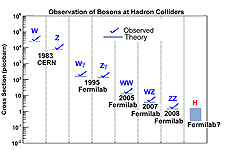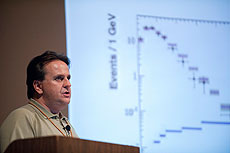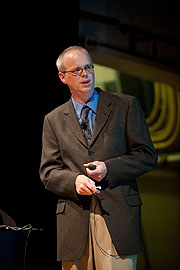Tevatron experiments prepare to shine at ICHEP

Over the last 15 years, the CDF and DZero experiments at Fermilab have discovered increasingly rare combinations of the electroweak force carriers — gamma, W and Z — emerging from proton-antiproton collisions at the Tevatron. With the Tevatron producing a record number of particle collisions, will the Tevatron experiments be able to catch a glimpse of the Higgs particle?

Marco Verzocchi, Fermilab, presented DZero results on Friday.

Tom Wright, of the University of Michigan, presented new CDF results on Friday.
On Friday afternoon, scientists from the CDF and DZero collaborations showed at a Fermilab seminar a large fraction of about 150 results that they will present at this year's International Conference on High Energy Physics, which will take place in Paris from July 22-28. ICHEP organizers have scheduled more than 40 talks and a large number of poster presentations on Tevatron results.
"This might be a record year in terms of the number of results produced," said Rob Roser, co-spokesperson of the CDF collaboration. "CDF and DZero have lots of results on searches for exotic particles and dark matter candidates, signs of symmetry violation and the search for the Higgs particle, not to mention the discoveries of new decay channels of known particles and the many precision measurements of numerous particle properties."
Both the CDF and DZero collaborations are taking advantage of the wealth of data delivered by the Tevatron particle collider. While the Large Hadron Collider in Europe now produces collisions at higher energy than Fermilab's collider, the Tevatron is still far ahead in the total number of collisions produced. Since 2001, the Tevatron has delivered nine inverse femtobarns of collisions per experiment, about 100,000 times more than the LHC has produced since its start in 2009.
"For many sought-after phenomena, such as new, heavy particles, the higher the collision energy the better the chance for discovery," said Dmitri Denisov, co-spokesperson of the DZero experiment. "But for some rare processes, including low-mass Higgs production, extra energy is less important than a large number of collisions produced. As we saw two months ago, the Tevatron experiments still can yield surprising results." In May, the DZero collaboration announced that B hadrons produced in proton-antiproton collisions seem to produce more muons than antimuons in their decays, evidence for a new type of matter-antimatter asymmetry.
On Friday, Marco Verzocchi, DZero, and Tom Wright, CDF, presented at Fermilab an overview of some of the new results the two collider experiments have obtained since the last major particle physics conferences, held in March. The two talks are available in the Fermilab streaming video archive. Next Monday, July 26, CDF and DZero will announce the highly anticipated result of their combined Higgs searches at the ICHEP conference. Fermilab Today will report the result.
With regard to the puzzling muon-antimuon asymmetry, announced just two months ago, the DZero collaboration will have no new numbers to show at ICHEP. According to Denisov, it will take about another six months before the DZero collaboration will present an update with an increased data set and advanced analysis.
"We expect to analyze substantially more data by the end of the year," Denisov said. "With the Tevatron cranking out more and more collisions, we might be at the edge of even more exciting discoveries."
-- Kurt Riesselmann
|
|